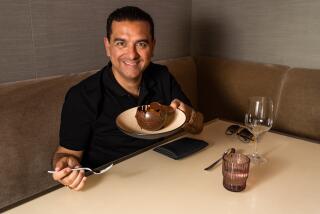Chocolate Tiles Sweeten Dessert Table
- Share via
One of the eye-catching features at the Party of the ‘90s staged by the National Assn. of Catering Executives was the decoration of the dessert tables with jaggedly broken, multicolored chocolate tiles.
The tiles were made by Susan Ettesvold, pastry apprentice at the Westin Bonaventure. Ettesvold picked up the idea from pastry chef and food artist Robert Lambert, who describes it in his book, “Fantasy Chocolate Desserts” (Chronicle Books: $14.95).
Lambert, of San Anselmo, regards the tiles as his signature technique. He cuts them into sheets to coat cakes, breaks them into pieces to form jaunty garnishes and colors them in imaginative ways.
The intricately patterned tiles look difficult to make, and they do require special materials. These are white pastel coating chocolate, which does not contain cocoa butter; powdered color or liquid candy color and parchment sheets. All can be found at cake and pastry supply houses. Once these products are obtained, the procedure is easy, and Ettesvold demonstrated the steps in The Times’ Test Kitchen.
First, she melted the cut-up chocolate in a steel bowl over a pan half-filled with simmering water. The water should not touch the bowl, and the chocolate must be kept at a constant temperature. Periodically lifting the bowl away from the water will help to avoid overheating, Ettesvold said.
Next, the warm chocolate is divided into bowls for coloring. Ettesvold explained that ordinary household food color cannot be used because it will cause the chocolate to “seize up,” or harden and become unusable.
The chocolate can now be tinted as desired. Or it can be left untinted and then patterned with streaks of color.
The tiles are molded on the back of a sheet pan. Using a paper towel, spread the back with a thin coat of vegetable oil and cover with a sheet of parchment. Ettesvold suggested keeping the melted chocolates warm and pliable by placing the containers over hot water.
Now pour the base color onto the prepared pan and with a spatula spread it in an even coat about the thickness of a quarter. If topping with a pattern such as stripes, place the desired color of coating chocolate in a parchment pastry cone or resealable plastic bag with one corner snipped off. For demonstration, Ettesvold piped color in straight lines back and forth across the length of the chocolate base. Then she pulled a skewer across the lines to produce an irregular design.
Ettesvold cautioned that the chocolate base coat must be kept warm during this procedure. If it hardens, slide the pan into an open 350-degree oven and watch carefully until it softens, a matter of seconds.
When the design is complete, give the pan a sharp tap or two on the counter to produce a level surface. Now let the chocolate dry at room temperature. This will take about 10 minutes.
When the tile is firm enough to handle, cut shapes with cookie cutters or a sharp knife and remove them from the parchment. Or peel the entire sheet from the parchment and break it into irregular shapes.
Ettesvold used some of the broken tiles to decorate a cake, which she also trimmed with piped-on puffs of whipped cream. The tiles are not fragile. According to author Lambert, they will keep for several weeks if covered and stored in a cool, dark place. Ettesvold noted that the chocolate may “bloom” if refrigerated. Therefore, they should be added to perishable desserts just before serving.
More to Read
Eat your way across L.A.
Get our weekly Tasting Notes newsletter for reviews, news and more.
You may occasionally receive promotional content from the Los Angeles Times.










